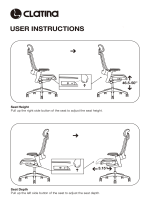
19
Always ask for help. Never
use an escalator, even if a care
giver is available. We always
recommend using two carers
for this transfer. One who
walks behind and holds on
to the push handle and one
who walks in front and holds
on to the frame (or in the
legrests if these are lockable).
With care giver, backwards:
- Turn the anti-tips upwards and
ensure that the push handles
are securely tightened.
- Reverse the wheelchair to the
first step.
- Tilt the wheelchair onto its rear
wheels.
- Pull the wheelchair slowly
upwards, one step at a time,
keeping it balanced on its rear
wheels at all times.
9 Driving technique, settings manoeuvring
9:5 Driving technique, stairs: up
9:6 Driving technique, stairs: down
Always ask for help.
Never travel on an escalator,
even if there are care givers
available. We always recom-
mend using two carers for
this transfer. One who walks
behind and holds on to the
push handle and one who
walks in front and holds on to
the frame (or in the legrests if
these are lockable).
With care giver, forwards:
- Be sure to turn the anti-tips
upwards and ensure that the
push handles are securely tight-
ened.
- Drive forwards to the first step
and tilt the wheelchair onto its
rear wheels.
- When the last step has been
cleared, continue backwards
so that the castors are on the
ground before setting down the
wheelchair on all four wheels.
Be sure to turn the anti-tips
back to the down position
after completed transfer.
(!) The care givers should remem-
ber to use the strength in their
legs and to keep their backs as
straight as possible while lifting.
- Descend carefully one step at
a time, keeping the wheelchair
balanced on its rear wheels at
all times.
- After the last step, set down
the wheelchair on all four
wheels.
Be sure to turn the anti-tips
back to the down position
after completed transfer.
(!) The care givers should remem-
ber to use the strength in their
legs and to keep their backs as
straight as possible while lifting.























